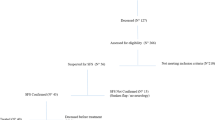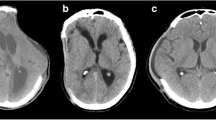Abstract
Decompressive craniectomy is reclaiming a role in neurocritical care. The altered pathophysiology found in a cranium converted from a ‘closed’ box to an ‘open’ box’ carries benefits and risks. In some craniectomy patients, the forces of atmospheric pressure and gravity overwhelm intracranial pressures, and the brain appears sunken. This can lead to paradoxical herniation and the sinking skin flap syndrome, also called the syndrome of the trephined. At the other polar extreme, external brain tamponade occurs when subgaleal fluid accumulates under pressure and ‘pushes’ on the brain across the craniectomy defect. The neuro-intensive care team should be prepared to diagnose and treat a spectrum of decompressive craniectomy complications including: cerebral contusions, infections, seizures, intra- and extra-axial hemorrhages and fluid collections, sinking skin flap syndrome or syndrome of the trephined, paradoxical herniation, and external brain tamponade. The treating physicians must set aside the Monro-Kellie doctrine and recognize the new pathophysiologic state of these ‘open box’ patients.







Similar content being viewed by others
References
Cushing H. The establishment of cerebral hernia as a decompressive measure of inaccessible brain tumors; with the description of intermuscular methods of making the bone defect in temporal and occipital regions. Surg Gynecol Obstet 1905;1:297–314.
Bliss M. Chapter 6: Opening the closed box. In: Harvey Cushing—a life in surgery. New York: Oxford University Press; 2005. p. 167–181.
Polin RS, Shaffrey ME, Bogaev CA, et al. Decompressive bifrontal craniectomy in the treatment of severe refractory posttraumatic cerebral edema. Neurosurgery 1997;41:84–94.
Ransohoff J, Benjamin MV, Gage EL Jr, et al. Hemicraniectomy in the management of acute subdural hematoma. J Neurosurg 1971;34:70–6.
Fisher CM, Ojemann RG. Bilateral decompressive craniectomy for worsening coma in acute subarachnoid hemorrhage. Observations in support of the procedure. Surg Neurol 1994;41:65–74.
Schwab S, Junger E, Spranger M, et al. Craniectomy: an aggressive approach in severe encephalitis. Neurology 1997;48:412–7.
Stefini R, Latronico N, Cornali C, et al. Emergent decompressive craniectomy in patients with fixed dilated pupils due to cerebral venous and dural sinus thrombosis: report of three cases. Neurosurgery 1999;45:626–30.
Vahedi K, Hofmeijer J, Juettler E, Vicaut E, George B, Algra A, Amelink GJ, Schmiedeck P, Schwab S, Rothwell PM, Bousser MG, van der Worp HB, Hacke W, for the DECIMAL, DESTINY, and HAMLET investigators. Early decompressive surgery in malignant infarction of the middle cerebral artery: a pooled analysis of three randomised controlled trials. Lancet Neurol 2007;6:215–22.
Sahuquillo J, Arikan F. Decompressive craniectomy for the treatment of refractory high intracranial pressure in traumatic brain injury. Cochrane Database of Systematic Reviews 2006, Issue 1. Art. No.: CD003983. doi:10.1002/14651858.CD003983.pub2.
Langfitt TW. Increased intracranial pressure. Clin Neurosurg 1968;16:436–71.
Falconer MA, Russell DS. Experimental traumatic cerebral cysts in the rabbit. J Neurosurg 1944;1:182–9.
Fodstad H, Love JA, Ekstedt JE, Frieden H, Liequist BL. Effects of cranioplasty on cerebrospinal fluid hydrodynamics in patients with syndrome of the trephined. Acta Neurochirurg 1984;70:21–30.
Richaud J, Boetto S, Guell A, Lazorthes Y. Incidences des cranioplasties la function neurologique et la debit sangein cerebral. Neurochirurgie 1985;31:183–8.
Sakamoto S, Eguchi K, Kiura Y, Arita K, Kurisu K. CT perfusion imaging in the syndrome of the sinking skin flap before and after cranioplasty. Clin Neurol Neurosurg 2006;108:583–5.
Aarabi B, Hesdorffer D, Ahn E, Carla Aresco C, Scalea TM, Eisenberg HW. Outcome following decompressive craniectomy for malignant swelling due to severe head injury. J Neurosurg 2006;104:469–79.
Kilincer C, Simsek O, Hamamcioglu MK, Hicdonmez T, Cobanoglu S. Contralateral subdural effusion after aneurysm surgery and decompressive craniectomy: case report and review of the literature. Clin Neurol Neurosurg 2005;107:412–6.
Goel A. Fatal tumoural haemorrhage following decompressive craniectomy: a report of three cases. Br J Neurosurg 1997;11:554–7.
Nornes H, Angelsen B, Lindegaard KF. Precerebral arterial blood flow pattern in intracranial hypertension with cerebral blood flow arrest. Acta Neurochir (Wien) 1977;38:187–94.
Grant FC, Norcross NC. Repair of cranial defects by cranioplasty. Ann Surg 1939;110:488–512.
Yamaura A, Makino H. Neurologic deficit following craniectomy. J Neurosurg 1976;45:362.
Bijlenga P, Zumofen D, Yilmaz H, Creisson E, de Tribolet N. Orthostatic mesodiencephalic dysfunction after decompressive craniectomy. J Neurol Neurosurg Psychiatry 2007;78:430–3.
Gardner WJ. Closure of defects of the skull with tantalum. Surg Gynecol Obstet 1945;80:303–12.
Schiffer J, Gur R, Nisim U, Pollak L. Symptomatic patients after craniectomy. Surg Neurol 1997;47:231–7.
Liao CC, Kao MC. Cranioplasty for patients with severe depressed skull bone defect after cerebrospinal fluid shunting. J Clin Neurosci 2002;9:553–5.
Oyelese A, Steinberg GK, Huhn SL, Wijman CA. Paradoxical cerebral herniation secondary to lumbar puncture after decompressive craniectomy for a large space-occupying hemispheric stroke: case report. Neurosurgery 2005;57(3):E594.
Fields JD, Lansberg MG, Skirboll SL, Kurien PA, Wijman CA. “Paradoxical” transtentorial herniation due to CSF drainage in the presence of a hemicraniectomy. Neurology 2006;67:1513–4.
Author information
Authors and Affiliations
Corresponding author
Rights and permissions
About this article
Cite this article
Akins, P.T., Guppy, K.H. Sinking Skin Flaps, Paradoxical Herniation, and External Brain Tamponade: A Review of Decompressive Craniectomy Management. Neurocrit Care 9, 269–276 (2008). https://doi.org/10.1007/s12028-007-9033-z
Published:
Issue Date:
DOI: https://doi.org/10.1007/s12028-007-9033-z




